
table of contents
- Bushes from B to C
- Shrubs from F to R
- Shrubs from S to T
- frequently asked Questions
Shrubs bloom in many colors, one of which is purple. However, purple flowers are rarer than other flower colors, such as white. A list of purple flowering shrubs and semi-shrubs can be found here.
In a nutshell
- Most of the purple flowering shrubs are easy to care for
- many are suitable for insects / bees
- some can also grow into small trees
- a few are evergreen
- some culinary herbs also bloom purple
Bushes from B to C
Beard flower (Caryopteris clandonensis)
- Origin: originally from East Asia, bred in England
- Growth and size: subshrub, 80 to 100 cm wide and high
- Bloom: July to September, blooms blue to purple
- Properties: conditionally hardy, leaves lanceolate, the whole plant smells aromatic, a little winter protection cannot hurt
- Care: full sun, protected location, dry soil, easy to care for, pruning improves flowering

Bastard indigo (Amorpha fruticosa)
- Origin: comes from North America
- Growth and size: 1 to 3 m high
- Flowers: upright racemes, June to August
- Characteristics: hardy, good bee pasture, leaves are pinnate unpaired
- Care: sunny location, dry to moist soil, little care
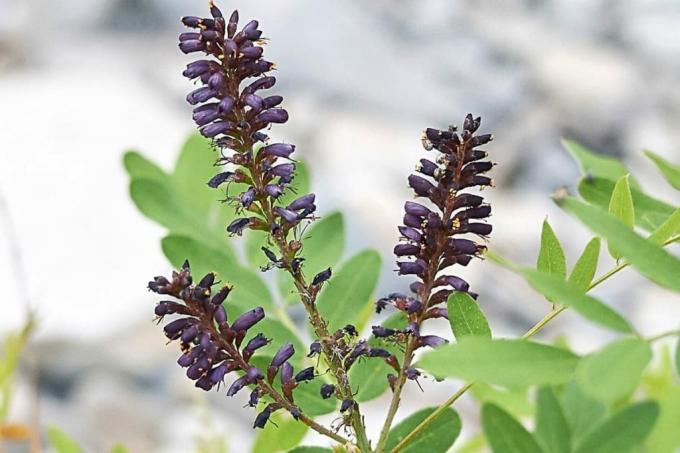
Common heather (Calluna vulgaris)
- Origin: native
- Growth and size: dwarf shrub, 40 to 50 cm
- Flower: upright, grape-like Inflorescence, July to November, blooming purple, but also white, yellow, orange, red, pink
- Characteristics: hardy, evergreen, leaves very small
- Care: sunny location, stony, dry soil, do not allow to dry out, cut away old flower stems
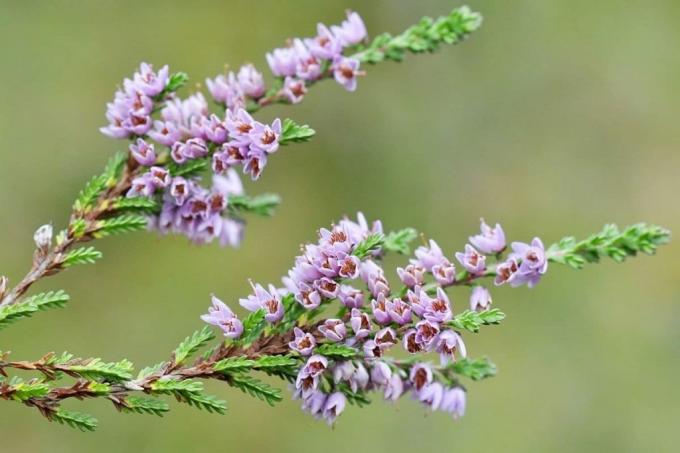
Blue diamonds (Perovskia)
- Origin: comes from Asia
- Growth and size: subshrub, 100 to 200 cm high
- Flowers: Lips flowers in panicles, purple flowers and also blue, August to September
- Properties: hardy, rod-shaped shoots with lanceolate leaves, aromatic fragrance
- Care: sunny location, dry soil, water only in case of prolonged drought, otherwise easy to care for, in spring cut back a hand's breadth above the soil

Chinese wisteria (Wisteria sinensis)
- Origin: comes from China
- Growth and size: actually a climbing plant, but can grow shrub-like, up to 10 m high
- Blossom: Butterfly blossoms in clusters, May to June
- Properties: hardy, very expansive, long-lived, pinnate leaves, bee pasture
- Care: sunny, warm, protected location, moist, permeable soil, climbing aid is needed when young, keep moist, forms nitrogen itself, twice a year cut back

Caution: Wisteria is poisonous in all parts, especially fruits and flowers!
Chinese judas tree (Cercis chinensis)
- Origin: comes from China
- Growth and size: a small tree in his home country, here as a shrub, up to 10 m high
- Flowers: plentiful, April to May, purple to red
- Properties: hardy, heart-shaped leaves, popular with insects
- Care: sunny, warm, protected location, permeable, calcareous and nutrient-rich soil, young plant needs winter protection, drought tolerant

Shrubs from F to R
Lilac (syringa)
- Origin: comes from Southern Europe to East Asia
- Growth and size: upright, compact, sometimes as a small tree, up to 7 m high
- Blossom: April to May, purple flowers, but also white, pink, yellowish, pleasant fragrance
- Characteristics: hardy, can form runners and then sprawl
- Care: sunny, warm location, permeable, rather dry soil, easy to care for, mulch from time to time or fertilize with compost, compatible with pruning, remove old flowers, rejuvenate pruning on old ones plants

Hydrangea
- Origin: most of the species come from America and Asia
- Growth and size: broad crown, up to 2 m high
- Flowering: July to September, also in blue or pink
- Characteristics: hardy, Shoots partially freeze back, large leaves
- Care: sunny to partially shaded location, slightly acidic, moist and well-drained soil, not too rich in nutrients, water and fertilize regularly, remove dead things after winter

Lavender (Lavandula angustifolia)
- Origin: comes from the Mediterranean region
- Growth and size: subshrub, compact growth with upright flower stems, up to 100 cm high
- Flowers: Lips flowers, June to August, purple blooms and also white and pink
- Properties: conditionally hardy, needle-shaped leaves, aromatic odor
- Care: sunnier Location, permeable, dry, sandy / stony soil, do not fertilize, water rarely, cut regularly

Love pearl bush (Callicarpa bodinieri)
- Origin: comes from China
- Growth and size: small shrub, up to 3 m high
- Bloom: June to September, also blooms pink
- Characteristics: hardy, purple, shiny berriesthat look like pearls, elliptical leaves
- Care: sunny, warm, sheltered location, permeable soil, keep moist, mulch, cut back every three years

Chaste tree (Vitex agnus-castus)
- Origin: comes from the Mediterranean and Western Asia
- Growth and size: subshrub, upright and bushy, up to 3 m high
- Flowers: spike-like panicles, September to October, purple flowers and also white, pink, red and blue
- Properties: hardy, narrow leaves, black, slightly poisonous berries, plant smells aromatic, bee pasture
- Care: sunny, warm location, stony, sandy soil, easy to care for, protect from moisture in winter
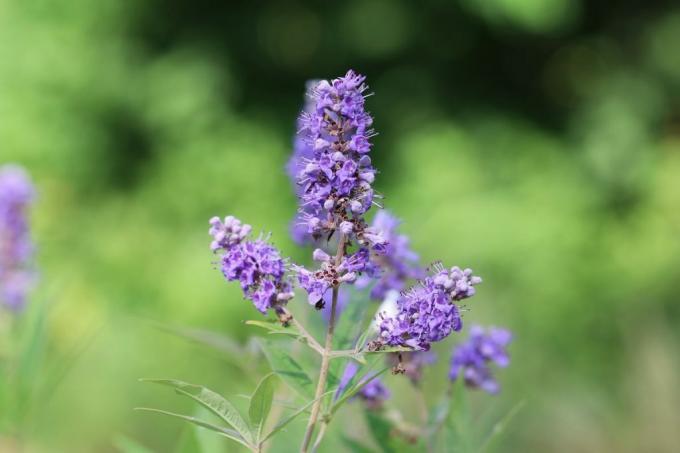
Rhododendron Alpine rose)
- Origin: partly native, partly from Asia
- Growth and size: depending on the species, staying 3 to 4 m or smaller
- Blossom: from April or May, purple blooming and also white, pink, yellow, red and blue
- Characteristics: hardy, evergreen, slow growing
- Care: partially shaded, protected location under a tree, acidic, moist, well-drained soil, keep moist, cut back after flowering

Shrubs from S to T
Sacflower (Ceanothus)
- Origin: comes from America
- Growth and size: small shrub, upright to overhanging, up to 1.50 m high
- Flowers: panicle shape, July to November, the purple flowers are sometimes blue
- Properties: conditionally hardy and evergreen, egg-shaped leaf shape
- Care: sunny, warm, protected location, sandy soil, loves lime, water only when it is dry, do not fertilize, remove faded in spring, protect in the first winters
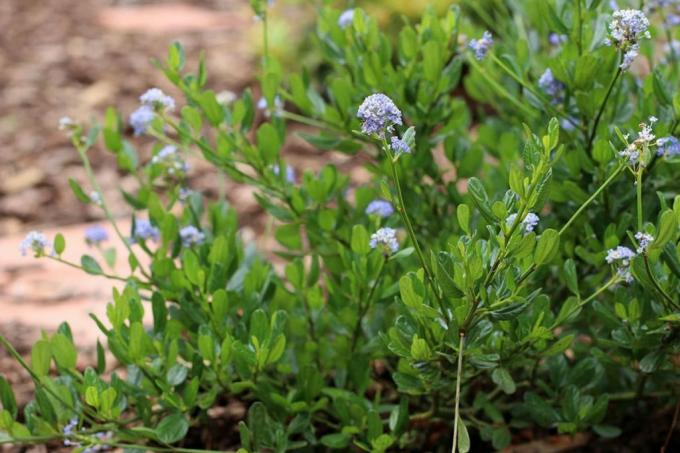
Sage (salvia)
- Origin: there are native species
- Growth and size: clump-like shrub, 30 to 50 cm high
- Flowers: Lips flowers in racemes, May to September, also white and pink flowering varieties
- Characteristics: conditionally hardy, leaves silvery green, hairy
- Care: sunny, warm location, well-drained, nutrient-rich soil, watering every now and then, winter protection is helpful, yearly Cut back

Butterfly lilac (Buddleja davidii)
- Origin: comes from China
- Growth and size: upright, up to 3 m high
- Blossom: similar to normal lilac, white, pink and lavender from July
- Properties: hardy, sometimes freezes back, remove dead things
- Care: sunny, warm location, not too moist, well-drained soil, also tolerates drought, hardly any care required, pruning in late winter, the stronger the bloom
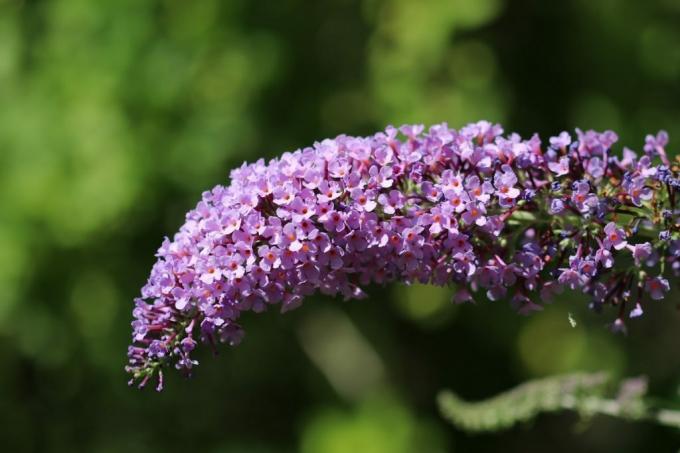
Note: Although lilacs and summer lilacs are similar, they are not related to each other.
Shrub Marshmallow (Hibiscus syriacus)
- Origin: comes from Asia
- Growth and size: upright, up to 3 m high
- Flowers: from August, white, pink, red and blue to purple flowers, flowers funnel-shaped
- Properties: mostly hardy, grows slowly, good bee pasture
- Care: sunny, protected location, well-drained, moderately moist soil, watering and fertilizing from time to time, pruning so that the shrub does not become bald

Note: The shrub marshmallow is also known under a variety of other names, for example: garden hawkish or -hibiscus, Sharon rose, Syrian marshmallow or festival flower.
Thyme (thymus)
- Origin: comes from the Mediterranean area, but there are also indigenous species
- Growth and size: small subshrub, cushion-forming, up to 40 cm high
- Flowering: from May, also white and pink flowers
- Properties: predominantly hardy, short, partly woody shoots, whole plant smells aromatic
- Care: sunnier, warmer, more protected Location, nutrient-poor, well-drained, calcareous soil, little watering, no fertilization, cut back from time to time

frequently asked Questions
A few can do this by sowing, but it takes a long time for the new plants to grow. A division or separation of runners is better. Bushes on this list can also be propagated using cuttings.
Basically, the shrubs should be cut compatible and bloom on annual wood. Lilac, for example, is well suited as a windbreak hedge.
This includes, on the one hand, all shrubs that remain small and, on the other hand, kitchen herbs, for example. Some varieties of the hibiscus can even be grown as house plants.
